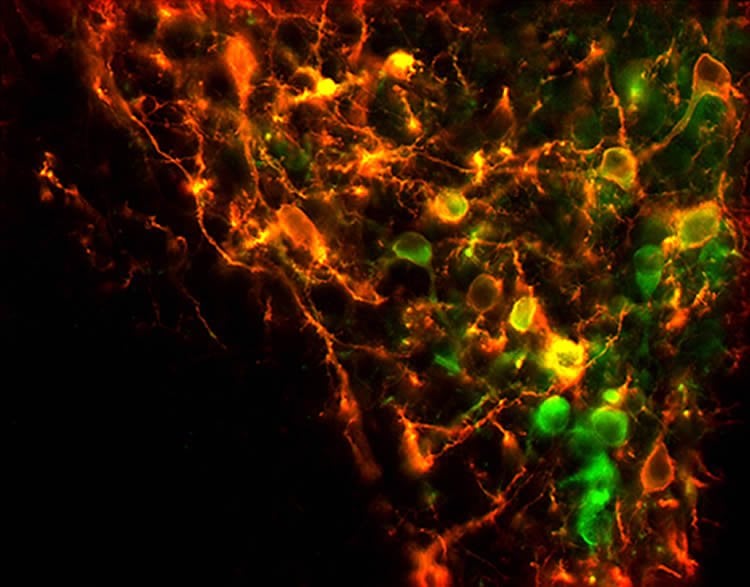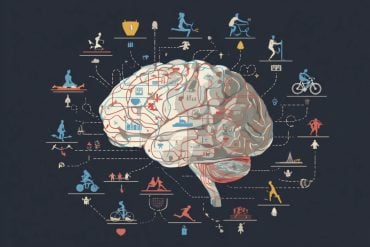Summary: According to a new study, a set of neurons previously linked to lactation may play a key role in regulating eating and body weight.
Source: Yale.
A set of neurons previously linked to lactation in women may also play a key role in regulating eating and body weight, a new study by Yale School of Medicine researchers has found.
Scientists have long known that an area of the brain called the arcuate nucleus of the hypothalamus played a key role in regulating energy metabolism and food intake. Much of the scientific enquiry relating to feeding has focused on the role of POMC neurons, which regulate food intake. Yale neurosurgery professor Anthony van den Pol and colleague Xiaobing Zhang investigated what neighboring tyrosine hydroxylase (TH) neurons do. When they used optogenetics to selectively activate the TH nerve cells in living mice, the animals began to eat, but when the researchers turned off the stimulating light, the mice stopped eating.

The investigators also found that transmitters the TH neurons release can inhibit both the POMC neuron and other neurons that control feeding. A hormone from the gut called ghrelin that can signal an empty stomach also excites the TH cells and trigger increased food intake. “Our study opens the door for further investigation of how these brain cells may contribute to obesity or other eating-related health problems” said van den Pol.
Source: Bill Hathaway – Yale
Image Source: This NeuroscienceNews.com image is adapted from the Yale press release.
Original Research: Abstract for “Hypothalamic arcuate nucleus tyrosine hydroxylase neurons play orexigenic role in energy homeostasis” by Xiaobing Zhang and Anthony N van den Pol in Nature Neuroscience. Published online August 22 2016 doi:10.1038/nn.4372
[cbtabs][cbtab title=”MLA”]Yale. “New Molecular Regulator of Eating Identified.” NeuroscienceNews. NeuroscienceNews, 23 August 2016.
<https://neurosciencenews.com/molecular-regulator-eating-4891/>.[/cbtab][cbtab title=”APA”]Yale. (2016, August 23). New Molecular Regulator of Eating Identified. NeuroscienceNews. Retrieved August 23, 2016 from https://neurosciencenews.com/molecular-regulator-eating-4891/[/cbtab][cbtab title=”Chicago”]Yale. “New Molecular Regulator of Eating Identified.” https://neurosciencenews.com/molecular-regulator-eating-4891/ (accessed August 23, 2016).[/cbtab][/cbtabs]
Abstract
Hypothalamic arcuate nucleus tyrosine hydroxylase neurons play orexigenic role in energy homeostasis
Energy homeostasis, food intake, and body weight are regulated by specific brain circuits. Here we introduce an unexpected neuron, the tyrosine hydroxylase (TH) neuron of the arcuate nucleus (ARC), that we show makes an orexigenic contribution. Optogenetic stimulation of mouse ARC TH neurons increased food intake; attenuating transmitter release reduced body weight. Optogenetic stimulation of ARC TH cells inhibited pro-opiomelanocortin (POMC) neurons through synaptic mechanisms. ARC TH cells project to the hypothalamic paraventricular nucleus; optogenetic stimulation of ARC TH axons inhibited paraventricular nucleus neurons by dopamine and GABA co-release. Dopamine excited orexigenic neurons that synthesize agouti-related peptide and neuropeptide Y but inhibited anorexigenic neurons that synthesize POMC, as determined by whole cell recording. Food deprivation increased c-fos expression and spike frequency in ARC TH neurons. The gut peptide ghrelin evoked direct excitatory effects, suggesting these neurons monitor metabolic cues. Together these data support the view that ARC TH cells play an unrecognized and influential positive role in energy homeostasis.
Hypothalamic arcuate nucleus tyrosine hydroxylase neurons play orexigenic role in energy homeostasis” by Xiaobing Zhang and Anthony N van den Pol in Nature Neuroscience. Published online August 22 2016 doi:10.1038/nn.4372






